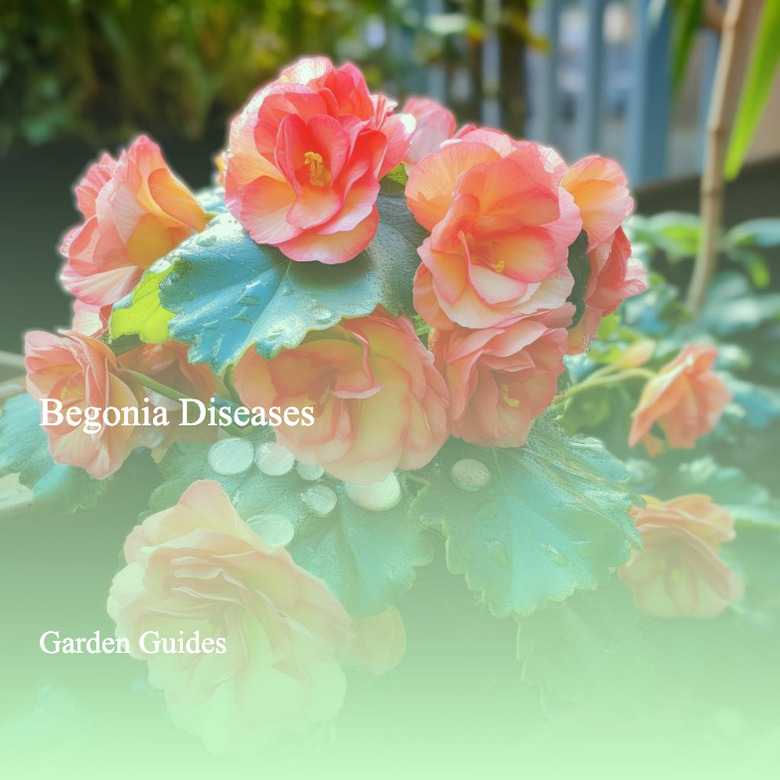Begonia Diseases
Begonias are tropical plants known for their waxy flowers and varicolored leaves. Begonias grow well in partially shaded, humid areas with moderate temperatures. Begonia categories include tuberous-rooted, rhizomatous and fibrous-rooted varieties. Although most begonias are grown indoors, these plants also work well as outdoor ornamentals. Begonias are susceptible to several diseases.
Bacterial Leaf Spot
Bacterial leaf spot (Xanthomonas campestris), one of the most common and wide-spread begonia diseases, is typically caused by excess moisture. This bacteria thrives in both dead and live begonia leaves and requires high temperatures ranging from 80 to 90 degrees Fahrenheit. Bacterial leaf spots first appear as small, blister-like growths on the underside of leaves near the main veins. These spots turn more brown with age and, if left untreated, will cause the begonia to lose its leaves and die.
- Begonias are tropical plants known for their waxy flowers and varicolored leaves.
Powdery Mildew
Another common begonia disease is powdery mildew. A fungus (Erysiphe cichoracearum) causes powdery, white spots to form on both lower and upper leaf surfaces. Greasy spots might form on the underside of infected leaves. Powdery mildew also might affect the flowers of fibrous begonia varieties. The fungus favors humid, shady areas with moderate temperatures. The fungal spores spread both through the water and through the air. A begonia plant can be seriously injured even by a mild infection.
- Another common begonia disease is powdery mildew.
- A fungus (Erysiphe cichoracearum) causes powdery, white spots to form on both lower and upper leaf surfaces.
Botrytis Blight
Botrytis blight (Botrytis cinerea), also called stem rot or brown rot, causes brown, moist spots to form on the flowers, leaves or stems. The lower leaves turn yellow and might drop. The begonia appears wilted but doesn't recover after being watered. The infected begonia plant typically develops a gray, fuzzy mold as the blight progresses. The begonia's root system becomes water-soaked and discolored. The roots eventually turn mushy and collapse. Botrytis blight also causes the seedlings to damp-off. Infected begonia plants die if the disease is left untreated.
- Botrytis blight (Botrytis cinerea), also called stem rot or brown rot, causes brown, moist spots to form on the flowers, leaves or stems.
- The begonia's root system becomes water-soaked and discolored.
Considerations
Begonia plants also are susceptible to Armillaria root rot, crown gall, black root rot, root knot nematode, cottony rot and foliar nematode. Once any signs of a begonia disease appear on a plant, the owner should remove the affected begonia and quarantine it from other plants. Spotted leaves must be carefully removed and burned. Any knives used for cutting an infected begonia should be disinfected with 70 percent rubbing alcohol before it is used on another plant. Soil from an infected begonia should be destroyed.
Prevention
Begonias that are properly cared for have far less risk of contracting one of the begonia diseases. Begonia plants should be planted a minimum of 9 inches from other plants so they receive adequate ventilation. Begonias should only be watered when the top soil is dry to the touch. Plant owners should avoid splashing the begonia's foliage with water and should not use overhead irrigation systems. Begonia plants should never be placed in direct sunlight because they can't tolerate high temperatures very well.
- Begonia plants also are susceptible to Armillaria root rot, crown gall, black root rot, root knot nematode, cottony rot and foliar nematode.
- Begonia plants should be planted a minimum of 9 inches from other plants so they receive adequate ventilation.
